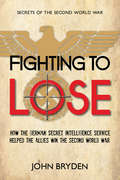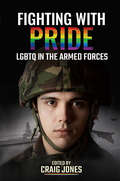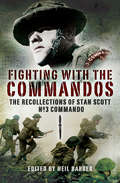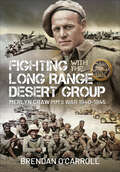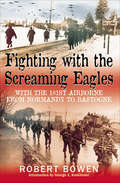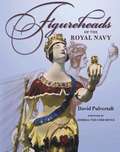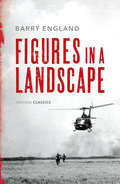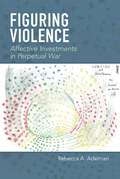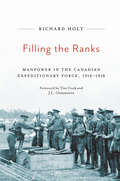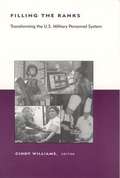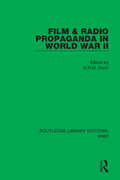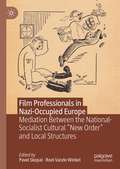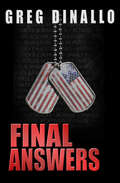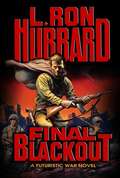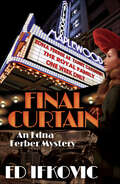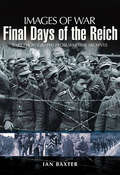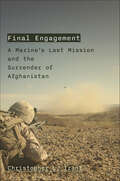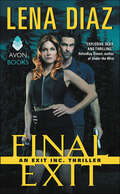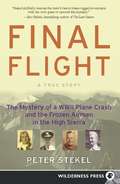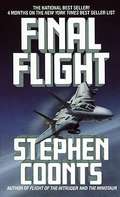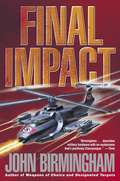- Table View
- List View
Fighting to Lose: How the German Secret Intelligence Service Helped the Allies Win the Second World War
by John BrydenStartling new revelations about collaboration between the Allies and the German Secret Service. Based on extensive primary source research, John Bryden’s Fighting to Lose presents compelling evidence that the German intelligence service — the Abwehr — undertook to rescue Britain from certain defeat in 1941. Recently opened secret intelligence files indicate that the famed British double-cross or double-agent system was in fact a German triple-cross system. These files also reveal that British intelligence secretly appealed to the Abwehr for help during the war, and that the Abwehr’s chief, Admiral Canaris, responded by providing Churchill with the ammunition needed in order to persuade Roosevelt to lure the Japanese into attacking Pearl Harbor. These findings and others like them make John Bryden’s Fighting to Lose one of the most fascinating books about World War II to be published for many years.
Fighting with Pride: LGBTQ in the Armed Forces
by Craig JonesLGBTQ+ personnel who served in the British military despite the gay ban tell their stories in a moving testament to their patriotism and courage.On January 12th, 2000, the British Armed Forces took a major step toward greater equality by ending its restriction against members of the LGBTQ+ community. To honor that historic event, this volume presents the personal reflections of ten LGBTQ+ personnel who had served under the ban since the Second World War. All of them lived remarkable lives, though some were dismissed in disgrace or asked to resign because of their identity.These brave men and women tell of remarkable careers, courage in battle, and private lives kept secret at all cost. They include stories of serving on the front line of operations worldwide, including in the Second World War, the Falklands War, the Gulf Wars and the war in Afghanistan. This book celebrates their lives, as well as all servicepeople who have stood tall and taken their place with pride in the fighting units of the Royal Navy, Royal Marines, Royal Air Force and the British Army.
Fighting with Pride: LGBTQ in the Armed Forces
by Craig JonesLGBTQ+ personnel who served in the British military despite the gay ban tell their stories in a moving testament to their patriotism and courage.On January 12th, 2000, the British Armed Forces took a major step toward greater equality by ending its restriction against members of the LGBTQ+ community. To honor that historic event, this volume presents the personal reflections of ten LGBTQ+ personnel who had served under the ban since the Second World War. All of them lived remarkable lives, though some were dismissed in disgrace or asked to resign because of their identity.These brave men and women tell of remarkable careers, courage in battle, and private lives kept secret at all cost. They include stories of serving on the front line of operations worldwide, including in the Second World War, the Falklands War, the Gulf Wars and the war in Afghanistan. This book celebrates their lives, as well as all servicepeople who have stood tall and taken their place with pride in the fighting units of the Royal Navy, Royal Marines, Royal Air Force and the British Army.
Fighting with the Commandos: Recollections of Stan Scott, No. 3 Commando
by Neil BarberFighting With The Commandos tells what the Second World War was like for a fighting soldier. After enlisting underage, he was 'found out', joined the Home Guard and then a Young Soldiers Unit (for those too young to serve overseas). He managed to get out to Iraq but was again sent home.He then joined 3 Commando led by Brigadier Peter Young and landed on SWORD Beach on D-Day. He graphically describes the action thereafter which included being among the first to reach Pegasus Bridge and relieve the glider borne troops under Major John Howard. Plenty of excitement and danger were to follow and readers will revel in a no-holds-barred memoir which points an illuminating picture of life for the rank-and-file in the build-up to the climax of the war.
Fighting with the Fourteenth Army in Burma: Original War Summaries of the Battle Against Japan 1943–1945
by James LutoThe Fourteenth Army was one of the most successful British and Commonwealth forces of the Second World War. It was not only the largest of the Commonwealth armies but was also the largest single army in the world with around half a million men under its command. Operating in the most inhospitable terrain, it drove the previously undefeated Japanese Army from the Indian border and out of Burma in an unrelenting offensive.The Fourteenth Army, often referred to as the Forgotten Army, was made up from units that came from all corners of the Commonwealth and was composed of thirteen divisions from East and West Africa as well as Britain and India. After the defeat of the Japanese these divisions compiled a summary of its actions and it is these unique documents that form the basis of this new book.Presented here together then for the first time is the story of war against the Japanese as told by each of the divisions that fought in that bitter conflict the original and authentic accounts untouched by the pens of historians.These accounts can never be supplanted and will be an invaluable source of information for generations to come. It will also help the many millions of relatives of those men that fought with the Fourteenth Army understand the complex campaign of 1943-1945.The Fighting Divisions of the Fourteenth Army is completed with citations for those actions which saw the award of the Victoria Cross and detailed Orders of Battle throughout the Fourteenth Army's existence to make this the most detailed study of its kind.
Fighting with the Long Range Desert Group: Merlyn Craw MM's War 1940–1945
by Brendan O'CarrollFormed in 1940 the Long Range Desert Group was the first Allied Special Forces unit established to operate behind German and Italian lines in North Africa. Its officers and men were volunteers recruited from British and Commonwealth units. Merlyn Craw was serving with the 2nd New Zealand Expeditionary Force when he joined the LRDG in 1941. He took part in numerous missions in the desert. The navigational driving and fighting skills of the LRDG were legendary and they were frequently responsible for transporting Stirling’s SAS detachments on raids. Merlyn’s luck ran out when he was captured on the Barce raid in September 1942, but he escaped twice, the second time making it back to Allied lines. Sent home on leave, he returned to Italy with the New Zealand Army. After a ‘disagreement’ he went AWOL and rejoined the LRDG with no questions asked, serving until the end of the war. Drawing on interviews with Merlyn and other former LRDG veterans, the author has created a vivid picture of this exceptional and highly decorated fighting man. Readers cannot fail to be impressed by the courage and ruthless determination of Merlyn Craw MM and his comrades.
Fighting with the Screaming Eagles: With the 101st Airborne from Normandy to Bastogne
by Robert BowenA member of the 101st Airborne&’s Glider Infantry recalls WWII, from the horror of D-Day to the despair of Nazi captivity, in this compelling memoir. As World War II broke out, Robert Bowen was drafted into Company C, 401st Glider Infantry, 101st Airborne Division. Soon afterwards, he found himself storming Utah Beach amid the chaos of D-Day, through unfamiliar terrain littered with minefields and hidden snipers. Bowen was wounded during the Normandy campaign but went on to fight in Holland and the Ardennes, where he was captured. That&’s when his &“trip through hell&” truly began. In each of Bowen&’s campaigns, the 101st &“Screaming Eagles&” spearheaded the Allied effort against the Nazi occupation of Europe. At Bastogne, they stood nearly alone against the onslaught of enemy panzers and grenadiers. His insights into life behind enemy lines after his capture provide as much fascination as his exploits on the battlefield. Written shortly after the war, Bowen&’s narrative is immediate and compelling. An introduction by the world&’s foremost historian of the 101st Airborne, George Koskimaki, further enhances this classic work.
Figureheads of the Royal Navy
by David PulvertaftThe first figureheads that were carved to represent the names of British warships appeared during the reign of Henry VIII; the last ones were carved in the early years of the twentieth century. During the intervening three hundred and fifty years it is estimated that some 5000 ships of the Royal Navy carried a figurehead of some description. This book follows the development of these diverse carvings, examining how the figurehead carvers interpreted the names and the symbolism incorporated in their designs. Evidence is drawn from a wide range of sources: contemporary ship models, ship plans, designs submitted for approval of the Navy Board and, of course, from those figureheads that have survived.Lavishly illustrated with much previously unpublished material, the book explores the wide range of subjects that were represented on the bows of Their Majesties Ships and recounts many of the stories that were told about them.The narrative is complemented by a catalogue that provides a brief description of each surviving figurehead, each carvers design drawing with its source and reference number as well as those ship plans and contemporary models that show the figureheads detail. This combination makes the book useful to a wide range of historians, researchers and anyone with an interest in Britains maritime past.
Figures in a Landscape
by Barry England'Masterful and beautifully written. Riveting and compellingly authentic. Grips you like a vice from the first page and never lets you go' Damien LewisTwo men are on the run. They have four hundred miles to go across hostile territory. Soldiers on the ground track them day and night, a helicopter circles above, life becomes a second-by-second fight for survival. Each muscle movement, drop of sweat, glance and instinct matters. Every second counts.Through long slogs across country, risky raids for supplies, moments of sheer panic, and under the intense pressure to survive, an unbreakable bond between two men is forged. This stunningly written, adrenaline-pumping novel is a little-known classic of its genre.SHORTLISTED FOR THE FIRST EVER BOOKER PRIZE IN 1969‘England's prose has the tough, spare elegance of steel scaffolding… a brilliant achievement’ The Times
Figuring Violence: Affective Investments in Perpetual War
by Rebecca A. AdelmanIn the United States, the early years of the war on terror were marked by the primacy of affects like fear and insecurity. These aligned neatly with the state’s drive toward intensive securitization and an aggressive foreign policy. But for the broader citizenry, such affects were tolerable at best and unbearable at worst; they were not sustainable. Figuring Violence catalogs the affects that define the latter stages of this war and the imaginative work that underpins them. These affects—apprehension, affection, admiration, gratitude, pity, and righteous anger—are far more subtle and durable than their predecessors, rendering them deeply compatible with the ambitions of a state embroiling itself in a perpetual and unwinnable war.Surveying the cultural landscape of this sprawling conflict, Figuring Violence reveals the varied mechanisms by which these affects have been militarized. Rebecca Adelman tracks their convergences around six types of beings: civilian children, military children, military spouses, veterans with PTSD and TBI, Guantánamo detainees, and military dogs. All of these groups have become preferred objects of sentiment in wartime public culture, but they also have in common their status as political subjects who are partially or fully unknowable. They become visible to outsiders through a range of mediated and imaginative practices that are ostensibly motivated by concern or compassion. However, these practices actually function to reduce these beings to abstracted figures, silencing their political subjectivities and obscuring their suffering. As a result, they are erased and rendered hypervisible at once. Figuring Violence demonstrates that this dynamic ultimately propagates the very militarism that begets their victimization.
Filling the Ranks: Manpower in the Canadian Expeditionary Force, 1914-1918
by J. L. Granatstein Tim Cook Richard HoltManpower is the lifeblood of armies regardless of time or place. In the First World War, much of Canada’s military effort went toward sustaining the Canadian Expeditionary Force, especially in France and Belgium. The job was not easy. The government and Department of Militia and Defence were tasked with recruiting and training hundreds of thousands of men, shipping them to England, and creating organizations on the continent meant to forward these men to their units. The first book to explore the issue of manpower in the Canadian Expeditionary Force, Filling the Ranks examines the administrative and organizational changes that fostered efficiency and sustained the army. Richard Holt describes national civilian and military recruitment policies and criteria both inside and outside of Canada; efforts to recruit women, convicts, and members of First Nations, African Canadian, Asian, and Slavic communities; the conduct of entry-level training; and the development of a coherent reinforcement structure. Canada’s ability to fill the ranks with trained soldiers ultimately helped make the Corps an elite formation within the British Expeditionary Force. Based on extensive research in British and Canadian archives, Filling the Ranks provides a wealth of new information on Canada"s role in the Great War.
Filling the Ranks: Manpower in the Canadian Expeditionary Force, 1914-1918 (Carleton Library Series)
by Richard HoltManpower is the lifeblood of armies regardless of time or place. In the First World War, much of Canada’s military effort went toward sustaining the Canadian Expeditionary Force, especially in France and Belgium. The job was not easy. The government and Department of Militia and Defence were tasked with recruiting and training hundreds of thousands of men, shipping them to England, and creating organizations on the continent meant to forward these men to their units. The first book to explore the issue of manpower in the Canadian Expeditionary Force, Filling the Ranks examines the administrative and organizational changes that fostered efficiency and sustained the army. Richard Holt describes national civilian and military recruitment policies and criteria both inside and outside of Canada; efforts to recruit women, convicts, and members of First Nations, African Canadian, Asian, and Slavic communities; the conduct of entry-level training; and the development of a coherent reinforcement structure. Canada’s ability to fill the ranks with trained soldiers ultimately helped make the Corps an elite formation within the British Expeditionary Force. Based on extensive research in British and Canadian archives, Filling the Ranks provides a wealth of new information on Canada"s role in the Great War.
Filling the Ranks: Transforming the U.S. Military Personnel System
by Cindy WilliamsThe war in Iraq and the problematic military occupation of that country have called into question the adequacy of America's all-volunteer force. Politicians and others have expressed doubts about its equity and capability; some have called for the reinstatement of the draft. Yet over the past twenty years the all-volunteer military has become a technologically advanced force that has contributed to America's overall military advantage. This book analyzes current military pay and personnel policies and identifies changes needed to maintain and improve America's all-volunteer force. Filling the Ranks argues that to attract qualified and motivated volunteers, the armed forces need to offer better tangible inducements -- pay, benefits, and training -- to accompany such intangible rewards as pride in serving one's country. Many of the policies related to tangible rewards were established shortly after World War II and are no longer effective. Filling the Ranks presents detailed assessments of US military pay and personnel policies in light of the strategic, demographic, economic, and labor realities of the future. It identifies specific problems that today's military career patterns, training, pay, and benefits pose for officers and enlisted men and women in both active duty and reserve forces, discussing such issues as competition with the private sector for talent, the need to restructure compensation, and provision of family support. It offers recommendations for more flexible, adaptive, and effective policies and a blueprint for achieving them.
Film & Radio Propaganda in World War II (Routledge Library Editions: WW2 #9)
by K.R.M. ShortThis book, first published in 1983, brings together leading world experts on film and radio propaganda in a study which deals with each of the major powers as well as several under occupation. By examining each nations’ propaganda content and comparing its various strands of output designed for different audiences, the historian is provided with an important source of a nation’s official self-image. Total war forced governments to formulate goals consistent with the received national ideology in order to support the war effort. To this extent, much of the domestic propaganda was directed towards stimulating the population to make sacrifices with promise of a new world if the peace were won.
Film Professionals in Nazi-Occupied Europe: Mediation Between the National-Socialist Cultural “New Order” and Local Structures
by Roel Vande Winkel Pavel SkopalThis book analyses the film industries and cinema cultures of Nazi-occupied countries (1939-1945) from the point of view of individuals: local captains of industry, cinema managers, those working for film studios and officials authorized to navigate film policy. The book considers these people from a historical perspective, taking into account their career before the occupation and, where relevant, pays attention to their post-war lives. The perspectives of these historical agents” contributes to an understanding of how top-down orders and haphazard signals from the occupying administration were moulded, adjusted and distorted in the process of their translation and implementation. This edited collection offers a more dynamic and less deterministic approach to research on the international expansion of Third-Reich cinema in World War Two; an approach that strives to balance the role of individual agency with the structural determinants. The case studies presented in this book cover the territories of Belgium, Czechoslovakia, France, the Netherlands, Norway, Poland and the Soviet Union.
Filming History from Below: Microhistorical Documentaries (Nonfictions)
by Efrén CuevasTraditional historical documentaries strive to project a sense of objectivity, producing a top-down view of history that focuses on public events and personalities. In recent decades, in line with historiographical trends advocating “history from below,” a different type of historical documentary has emerged, focusing on tightly circumscribed subjects, personal archives, and first-person perspectives. Efrén Cuevas categorizes these films as “microhistorical documentaries” and examines how they push cinema’s capacity as a producer of historical knowledge in new directions.Cuevas pinpoints the key features of these documentaries, identifying their parallels with written microhistory: a reduced scale of observation, a central role given to human agency, a conjectural approach to the use of archival sources, and a reliance on narrative structures. Microhistorical documentaries also use tools specific to film to underscore the affective dimension of historical narratives, often incorporating autobiographical and essayistic perspectives, and highlighting the role of the protagonists’ personal memories in the reconstruction of the past. These films generally draw from family archives, with an emphasis on snapshots and home movies.Filming History from Below examines works including Péter Forgács’s films dealing with the Holocaust such as The Maelstrom and Free Fall; documentaries about the Israeli-Palestinian conflict; Rithy Panh’s work on the Cambodian genocide; films about the internment of Japanese Americans during the Second World War such as A Family Gathering and History and Memory; and Jonas Mekas’s chronicle of migration in his diary film Lost, Lost, Lost.
Final Answers
by Greg DinalloGreg Dinallo, the heralded author of Rockets&’ Red Glare and Purpose of Evasion, has written his most chilling and disturbing thriller yet: A novel of intrigue that explores the emotionally charged issue of Vietnam War MIAs. Final Answers is provocative, authentic, and powerful fictionAmong the 58,176 names etched on the long black wall of the Vietnam Memorial in Washington, DC, are names of those who never came home—of MIAs whose families are still waiting for final answers.During a business trip to Washington, a veteran, now a statistics expert, has an experience at the Memorial that will shatter his carefully constructed life with the impact of a Claymore mine. Touching the names carved in the wall, he finds one all too familiar: his own. A. Calvert Morgan understands cold, hard numbers. But how did his name get on the wall? Morgan&’s wife, Nancy, does some research for him that leads him to Kate Ackerman. Kate&’s husband had been listed as missing in action after being shot down in Laos twenty years earlier; during those years, she has joined the National League of Families and become a dedicated MIA activist.At first, Morgan believes that he is part of a bizarre military snafu—a data entry error made in the field. But when Kate guides him to the Army&’s Central Identification Lab in Hawaii, he begins to realize that his &“death&” was not an accident. In the war zone, another man took his name and serial number for his own —and then was killed. Morgan finds out that his impersonator was no ordinary GI He was, in fact, a key player in a macabre conspiracy that reaches back to the poppy fields of Laos.Morgan has set off a deadly alarm; the drug lord is still operating and has targeted him for elimination. Coming after Morgan—a man more comfortable with a computer than a handgun—the hit man commits a murder so brutal that Morgan&’s life is turned into a raging fight for survival.From the San Francisco mortuary that received the bodies of American servicemen during the war to Southeast Asia in the &’90s, Morgan is venturing into ever more violent territory. And he is not alone. Kate Ackerman has joined him on a trip to Thailand—hopeful that her husband is still alive, his fate possibly linked to those who have targeted Morgan for death.Amid Bangkok&’s steamy nightclubs and brackish, twisting canals, their quest pushes them into the jungle, across the Mekong River into Laos, where they move toward a brutal final answer to the mystery of Vietnam MIAs . . .Electrifying and filled with suspense, Final Answers confirms Greg Dinallo&’s reputation as a novelist who poses daring questions, takes extraordinary risks, and delivers searing excitement from first page to last.
Final Blackout
by L. Ron HubbardTriumphant tale of heroes, honor and impossible odds. As the great World War grinds to a halt a force more sinister than Hitler's Nazis has seized control of Europe and is systematically destroying every adversary -- except one. In the heart of France a crack unit of British soldiers survive, overcoming all opposition under the leadership of a hardened military strategist highly trained in every method of combat and known only as "The Lieutenant". Ordered to return to British Headquarters, the Lieutenant is torn between obeying the politicians in London or doing what he knows is right for his country, regardless of the price.
Final Curtain (Edna Ferber Mysteries #Bk. 5)
by Ed IfkovicWho murdered the handsome young actor? And why?In 1940, against the chilling backdrop of Hitler's rise and the specter of another war, Edna Ferber decides to follow an old dream: to act on the stage. Selecting The Royal Family, the comedy she wrote with George S. Kaufman, for her starring role, she travels to Maplewood, New Jersey. But her escape from the troubling daily headlines is short lived. Before opening night, a mysterious understudy is shot to death, opening up a world of lies, greed, and hypocrisy.Ferber, along with Kaufman, who is directing the production, begin a different kind of collaboration: the discovery of the murderer. As rehearsals evolve, they deal with a cast of characters who are all hiding something from their days spent in Hollywood: a stage manager, a young ingénue, an American Nazi and his boisterous girlfriend, a stagehand named Dakota who is the son of a famous evangelist, his charismatic preacher-mother, her money-bags husband, and a driven acolyte of the church. Each character, Edna discovers, has some connection with the dead man. Why have they all converged on quiet Maplewood? As Edna investigates, she realizes that the answer to the murder lies back in Hollywood.As Kaufman wisecracks his way through the story, Edna methodically examines the facts, determined to find the answer. Opening night looms and so does World War II. Edna, resolute, believes that justice needs to prevail in a world that is falling apart.
Final Days of the Reich: Rare Photographs from Wartime Archives (Images of War)
by Ian BaxterA pictorial history of the end of World War II from the perspective of Nazi Germany. Drawing on rare and previously unpublished photographs accompanied by in-depth captions and text, this book is a compelling account of the final weeks of the Nazis&’ struggle for survival against overwhelming odds. Each photograph fully captures the tension, turmoil, and tragedy of those last, terrible days of war as Wehmacht, Waffen SS, Luftwaffe, Hitlerjungend, Volkssturm, and other units, some of which were comprised of barely trained conscripts, fought out their last battles. Exhausted and demoralized skeletal units must have been aware of the impending defeat. Yet the German General Staff was still resolved to fight at all costs. By late March 1945, less than 100 miles east of Berlin, some 250,000 German troops had slowly withdrawn to the Oder, and what followed was a series of fierce and determined defensive actions that would finally see the Germans encircled and fighting the last desperate battle within Berlin itself against overwhelming odds.
Final Engagement: A Marine's Last Mission and the Surrender of Afghanistan
by Christopher L. IzantThrough a deadly last showdown beside Afghan forces fighting the Taliban, Marine Corps veteran Christopher Izant illustrates the impossible conditions and strategic blunders that disillusioned a generation of American warriors and all but guaranteed defeat.They were stepping into a world of hidden minefields, cultural clashes, "green-on-blue" insider attacks, and a patient, relentless enemy. But Christopher Izant and the Marines on his team volunteered to train and fight alongside the Afghan National Security Forces despite the risks and a seemingly futile mission they would term "advise and abandon" made by policymakers a world away.Final Engagement embeds readers with then-Lieutenant Izant and his team of combat advisors at Combat Outpost Taghaz during one of Operation Enduring Freedom's most crucial and challenging campaigns. It was 2012, southern Helmand Province, and with fixed base-closure and withdrawal timelines, the Marines had only six months to sustain the hard-won victories of the infantry units and prepare the Afghan Border Police to stand on their own. But before Border Advisory Team 1 lay down arms, there would be one last deadly battle with a devastating aftermath.Izant relives a fight in the Afghan borderlands that forebode the fall of Kabul nearly a decade later and confronts the violence and anguish that transformed a generation of American and Afghan warriors from idealist volunteers for a just war to disillusioned veterans of a lost cause.
Final Exit: An Exit Inc. Thriller (EXIT Inc. Thrillers #3)
by Lena DiazLena Diaz concludes her sexy, suspenseful EXIT Inc. series as an FBI agent teams up with a beautiful assassin to uncover a deadly government conspiracy...After a tragic mistake nearly destroyed his life, Special Agent Kade Quinn will do whatever it takes to save his career. His latest mission? Track and capture the remaining EXIT operatives to determine if they’re still a threat. But his next target—a stunning female assassin—is both elusive and dangerously appealing. Bailey Stark has outsmarted the FBI so far, but she’s tired of running. Tired of watching her friends ambushed by government agents in tactical gear and never seen again. She suspects they aren’t being evaluated—they’re being exterminated—and she’s determined to convince Agent Quinn his mission is a lie before it’s too late. Bailey doesn’t want to rely on him. She definitely shouldn’t desire him. But she knows teaming up with the skilled, sexy agent may be her only hope. Kade doesn’t want to believe Bailey’s claims, but he promises to keep her safe. Trusting one another is difficult. Fighting their attraction is harder. And as they uncover the disturbing truth behind his mission . . . staying alive will be nearly impossible.
Final Flight
by Peter StekelIn October 2005, two mountaineers climbing above Mendel Glacier in the High Sierra finds the mummified remains of a man in a WW II uniform, entombed in the ice. The "Iceman" discovery creates a media storm which draws author Peter Stekel to investigate and stumble upon the case of a navigation training flight crew missing since 1942. Early attempts at recovery are thwarted due to empty graves, botched records, bad weather, bad luck, and bad timing. Then, in 2007, Stekel himself discovers a second body in the glacier. Through meticulous research, interviews, and his own mountaineering trips to the site, Stekel uncovers the identities of these four young men. Final Flight explores the story of the ill-fated flight and the misinformation surrounding it for over 60 years. The book is a gripping account that's part mystery, part history, and a personal journey to uncover the truth of the events that occurred on November 18, 1942. In the process, Stekel rewrites the young aviators' last days and takes us on their final flight.
Final Flight (Jake Grafton Ser. #Vol. 2)
by Stephen CoontsThe most daring -- and deadly -- terrorist plot of all time is about to unfold aboard the supercarrier USS United States. If it succeeds, the balance of nuclear power will tilt in favor of a remorseless Arab leader. And it looks as if no one can stop it - except navy "jet jock" Jake Grafton. "Cag" Grafton is one helluva pilot. His F-14 Tomcat is one helluva plane. But some of Jake's crewmates have already vanished. A woman reporter who boarded the ship in Tangiers may not be who she claims to be. And Jake may have to disobey a direct order from the President himself for one spine-tingling, hair-raising Final Flight
Final Impact: A Novel of the Axis of Time (Axis of Time #3)
by John Birmingham"The action is nonstop, the characters very real-and very different from each other-and, to coin a phrase, it makes you think." -S. M. Stirling, author of Island in the Sea of Time. In the year 2021 a multinational fleet-experimenting with untested weapons technology-pitched through time, crash-landing in 1942. The world is thrown into chaos as Roosevelt, Hitler, Churchill, Tojo, and Stalin scramble to adapt to new, high-tech killing tools, and twenty-first-century ways of war. For "uptimers" like Britain's Prince Harry and the men and women who serve aboard the supercarrier USS Hillary Clinton, war is a constant struggle with their own downtime allies, who are mired in ignorance and bigotry. As the Allies counter the Nazi assault and set off for the coast of France, Japan begins to buckle, soon every battle will be played out in a lethal dance of might and intelligence, unholy alliances and desperate gambles, and each clash will be fought with the ultimate weapon; knowledge from the future. Thanks to the historical records, all sides know that two superpowers will emerge, while the losers will be pounded into submission. But time has shifted on its axis, so none know who will survive, or how peace will take hold in a world turned upside down. These are the questions that John Birmingham brilliantly answers in his critically acclaimed adventure of war and imagination. Praise for John Birmingham's Weapons of Choice "Birmingham's enthralling battleground mixes provocative historical fiction and socially conscious futurism." -Entertainment Weekly. "High-tech intrigue and suspense similar to the works of Tom Clancy." -Library Journal
